
Taking
a Peek At Our Environmental Future
Travel Office Upgrades
Will Simplify process, Save Money
Taking a Peek At Our Environmental Future

Berkeley Lab’s Carl Steefel and Glenn Waychunas want to see into the future — but not just any future. The two earth scientists are part of a Penn State University-led initiative launched in early October that will use supercomputers, state-of-the-art imaging, and lab experiments to predict some fundamental environmental processes, such as how quickly pollutants react with minerals in soils and aquifers, and the rate at which the chemical weathering of rock traps carbon dioxide, a greenhouse gas.
Called the Center for Environmental Kinetics Analysis, the multi-institutional group of chemists, geochemists, biochemists, soil scientists and engineers will also explore the rate, or kinetics, of these reactions at a variety of scales, from nanometers to meters. Their goal is to gain a deep understanding of these processes at the microscopic level — down to the single pore and molecule — and learn how they impact longstanding environmental bugaboos such as toxic runoff and carbon sequestration.
“We ultimately want to predict how long an environmental system takes to form, how long it takes to change, and what we can do to affect its rate of change,” says Waychunas, a geochemist in the Earth Sciences Division. “We need to be able to predict the consequences of different kinds of environmental disturbances, which is a necessary step in learning how to mitigate pollution.”
The center is one of seven Environmental Molecular Science Institutes funded by the National Science Foundation (NSF) and dedicated to understanding how human activity and nature contribute to environmental problems at the molecular level. NSF awarded $6.7 million to the group of researchers to establish the center, which is headed by Penn State University geochemist Susan Brantley. DOE awarded an additional $2.5 million over five years to Steefel, Waychunas, Peter Lichtner of Los Alamos National Laboratory, and John Zachara of Pacific Northwest National Laboratory to contribute their expertise.
Together, the researchers will take a new look at an old problem. When studying a contaminated site, scientists have traditionally sought to catalog all of the minerals, microbes and chemicals present. They have also analyzed the rate at which these components react with each other. But they have not fully studied these biogeochemical reactions at the pore scale, and they don’t know how these rates translate to much larger systems such as aquifers and sediments.
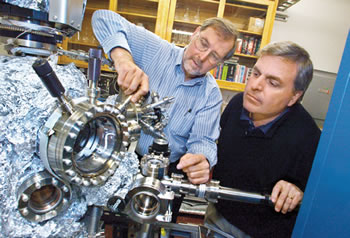 Waychunas
(left) and Steefel inspect a device used to grow and monitor nanocrystals
of interest to environmental and earth scientists.
Waychunas
(left) and Steefel inspect a device used to grow and monitor nanocrystals
of interest to environmental and earth scientists.
Because the relationship between scale and kinetics is generally overlooked, scientists are stymied in their ability to devise the best clean-up strategies. To keep toxins from seeping into a river, for example, they must know how fast the toxins move, how quickly they react with their surroundings, and how quickly chemical and microbial remediation efforts curb their spread. And because these reactions occur at the molecular level, they must study these processes at the smallest dimensions, then scale them up to sites that span tens of square meters.
For Waychunas, this means analyzing the rate at which minerals form, dissolve, and react with other compounds. Previous inquiries into this phenomenon have been plagued by the fact that reactions in the lab occur much more quickly than they do in the field. The reason is simple: the real world is dirtier and more varied than the lab. At an aquifer at Massachusetts’ Cape Cod, for example, the surfaces of sand grains are peppered with aluminum silicates and iron oxides. Contaminants react with this coating instead of the sand itself, as in a lab. Waychunas hopes to understand how fast such coatings are generated, and how reactive they are.
Also at the molecular level, Waychunas hopes to gain a better understanding of the number of reactive sites on a mineral, which is often overestimated in the lab. And at the micron level, he hopes to learn how a mineral’s topology affects the way it aggregates with other minerals, and the way chemicals precipitate onto it.
“Right now, we just know pieces of what happens in the field, and we have idealized lab experiments that run too fast,” says Waychunas. “The kinetics of some isolated processes are known fairly well, such as the weathering of quartz and granite, but we need to understand the kinetics of heterogeneous and complicated systems in nature.”

The multi-institutional group will help determine how quickly contaminants
react with their surroundings.
Steefel, also a geochemist in the Earth Sciences Division, will also start small and then try to go big. First, he wants to gain a mechanistic understanding of the processes that control biogeochemical reaction rates in porous material by focusing on a single pore. In a common scenario, there may be a reactive mineral on one side of a pore and biofilm on the other side. How do they communicate? To answer this question, Steefel and several other scientists will conduct reactive flow experiments using single-pore microfluidic devices. They’ll also monitor how fluid reacts with porous samples using imaging technology with a spatial resolution of about 30 nanometers, such as the Advanced Light Source’s scanning transmission x-ray microscope (STXM). They will probably begin with a calcium carbonate mineral that has been studied extensively — but never at the pore scale — and observe the rate at which a slightly acidic solution reacts with the mineral as it flows through.
Next, this pore-by-pore data will be used to develop supercomputer-derived models that depict the rates of these reactions in a much larger sample of porous material.
“The idea of scaling kinetics is a frontier issue, but that’s what this project is about,” says Steefel. “If we develop a mechanistic understanding of reactive transport at several scales, then we can devise predictive models for bioremediation, chemical weathering, and carbon sequestration. And only through the convergence of modeling, supercomputers, synchrotron techniques, and advanced microfluidic reactors is this possible.”
Travel Office Upgrades Will Simplify Process, Save Money
Berkeley Lab employees frustrated at times about the process of booking, authorizing, and obtaining reimbursements for travel can take heart: Help is on the way!
Through an upgrade effort that goes back two years — actually 10 years, if you count the first time such problems and automated upgrades were discussed — the Travel Office is honing in on a package of cyber-based tools and agency partnerships that should begin to reduce the cumbersome paperwork and procedural delays that have left many a user flustered.
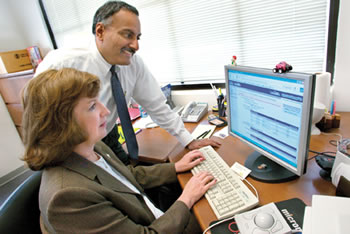
ASD head Anil More and travel manager Carole Johnson are using a new
and improved version of the Gelco online travel program, which promises
to be more efficient and cost-effective. Photo by Roy Kaltschmidt,
CSO
It all starts with Gelco, the selected commercial travel software for the online travel expense management system. “The electronic system eliminates redundancies,” says Lab travel manager Carol Johnson. “Our legacy system was archaic, in an old programming code. It was cumbersome to make changes, and involved multiple points of entry. Data was entered numerous times in different systems, creating numerous opportunities for error.”
Not to mention the inconvenient wait for reimbursement checks. When the new Gelco system is cooking — and it has been since its implementation 18 months ago — travelers get their checks in two days for domestic travel, a process that takes three or four weeks in the paper process. There’s also a considerable cost savings: the expense of a single transaction should drop from $100 to about $20, providing significant savings to the Lab budget, according to Administrative Services head Anil More.
It wasn’t as easy as just installing software, he points out. “We have about 7,000 transactions a year,” he says. “We’ve had to bring numerous systems together — human resources, accounting, banks, the travel agency, the federal travel regulations (CONUS rates). Government travel is complicated. Plus it’s more difficult here (at the Lab), with numerous different computer systems in use.”
An early roll-out of the Gelco program this year was rocky, to say the least. It looked great conceptually — for travelers and approvers, it represented easily accessible web-based documents which could be routed electronically for approval. All would work from the same electronic documents, with no paper except for receipts or print-outs (if desired) for the files. But reality proved different. Test users found it difficult to navigate, with unfamiliar terminology and way too many screens to sort through. Customers were not thrilled.
Enter Gelco version 8.2, an improved system which reduces the number of screens and is more intuitive and easier to use. More and Johnson visited the Gelco home office, the Department of Homeland Security — one of Gelco’s largest clients — and other agencies as well as consulting with critical system users in several different divisions before making the recommendation to upgrade. With this upgrade, plus the use of the Project Management Model and partnerships between Information Technologies, Business Services and the customer divisions, the experience is expected to be much smoother.
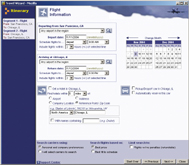 The
Lab is about to launch the Cliqbook travel software, which will do
concurrent searches for the lowest fares and prices.
The
Lab is about to launch the Cliqbook travel software, which will do
concurrent searches for the lowest fares and prices.
Online booking has been another challenge, given the Lab’s YCAL reduced-fare program and the prevalence of competing user-friendly public websites. A nifty program called Cliqbook, due for a Nov. 22 launch, will do concurrent searches of web travel sites to seek out the lowest fares and prices. Cliqbook is easy to use in booking airlines, hotels and cars. Johnson says most users can book a flight in two minutes, adding that Lab users who previewed it are unanimous in their praise.
In addition to systems upgrades, the travel folks have been equally aggressive in keeping contract costs down. They renegotiated lower fees with the Carlson agency and joined the Livermore Lab in convincing United Airlines to restore low-cost options when the state’s YCAL program dropped them. Now known as “K” fares, they cover 30 frequently traveled destinations in the U.S. and 12 abroad and are comparable to those offered through YCAL by other carriers. Savings incentives for advance-purchase and last-minute reservations are also included. United bookings represent about 70 percent of all lab air travel.
The “K” fares will be included in Cliqbook’s search program, according to Johnson. And those who book online save the Lab about one-third the cost of booking through the agency. About half of all Lab travelers currently book online, and that should go up with Cliqbook, she says.
This integrated look at travel “makes the whole process easier for the user,” More says. “We are responding to user needs, and saving money for the Lab as well as the scientific programs.”
In addition to the monthly tutorials on Gelco (version 8.1 is currently being used), the Travel Office will offer hands-on Cliqbook training on Nov. 15, 17 and 18 in the Building 90 computer training room. Employees can sign up for classes on the Human Resources’ Employee Self-Service site.
Questions may be addressed to the Travel HotLine, at X4500.
Travel ‘Revolution’ Takes Teamwork, Innovation
The changes and upgrades to the Laboratory’s travel program aren’t happening overnight, as Travel Manager Carol Johnson is quick to point out. And they were not achieved by a few individuals. This was a classic team effort.
Credit can be spread widely, starting in 1994 when a report of a travel process improvement team concluded, “The goal of the (team) is to help make travel simple and painless at LBNL for all those involved in the travel process.” Since then, it’s been an uphill road, given the complexities of Laboratory systems and the revolution in travel system technology. According to ASD head Anil More, e-travel has become a realistic tool for business travel only in the last five years.
Since 2001, a core team of planners — Steve Rossi of the Advanced Light Source, Aurora Pecoraro from Accounting, Sally Lafferty of Information Systems and Security, and travel staffers Mary Clary and Betty Strausbaugh of Business Systems (now under the Chief Financial Officer) worked weekly to get a new system into place. A steering committee comprised of Johnson, Information Technology’s Diana Brown and Rich Nosek, and More directed the effort.
The Gelco system was piloted at the ALS in 2003, but that was just the beginning. In 2004, Johnson says, “We partnered with ISS (Information Systems and Services) and critical users at a management level from the divisions.” She gives special credit to Ben Feinberg at the ALS, Rick Gough of Accelerator and Fusion Research, Nancy Padgett of Environmental Energy Technologies, and Fay Mitschang of Business Services for their valuable input. Finally, “We tested our proposal with CSAC (Computing Services Advisory Committee) and other groups that validated we were taking the right path.”
A recently-formed Travel Advisory Committee (TAC) provides user input on policies, procedures and systems. Members include Linda Brown, Bernadette Dixon, Ellen Ford, Laura Johnson, Kim Magbie, Mitschang, Gail Mosley, Padgett, Elizabeth Saucier, Marion Skidmore, Ann Tomaselli, Maryann Villavert, Susan Waters, June Wong, and Melanie Woods.
First Larimer Scholarship Awarded to Jennie Guzman
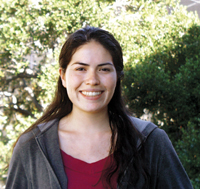 Award
winner Jennie Guzman
Award
winner Jennie Guzman
Jennie Sara Guzman, a UC Berkeley physics major, is the first recipient of a scholarship established in memory of Ruth-Mary Larimer, whose nuclear-science career spanned half a century. The award is intended to encourage outstanding undergraduates in the UC Physics Department, with attention to women who plan careers in the field of nuclear science. Guzman will receive a certificate and a check for $500 in a ceremony to be held at the 88-Inch Cyclotron at 3 p.m. on Nov. 19.
Ruth-Mary Larimer was born in 1926, began work at what was then the Radiation Lab in 1954, and moved to the 88-Inch Cyclotron in 1962. Although officially retired in 1991, she was still working at the 88-Inch until a few months before her death in November 2003. “She was the heart and soul of the cyclotron for almost 40 years,” says Peggy McMahan Norris, research coordinator at the 88-Inch.
A Stanford graduate with a political science degree, Larimer started as a health physicist at the Rad Lab and worked there until the 88-Inch was built. Over the years she assembled numerous beam lines and equipment with attention to strict radiation safety. In the late 1990s Larimer helped build the BEARS radioactive-isotope transfer line, and in 2000 she received both an Outstanding Performance Award and a Nitsche Award, the latter for her contributions to the polarized ion beam program.
Rick Norman, formerly of the Nuclear Science Division (NSD) and now at Livermore, says, “Ruth-Mary was kind of the mother here. She took care of everybody and made sure experiments were done safely and productively. She knew everybody on the Hill, and she knew how to get things done.”
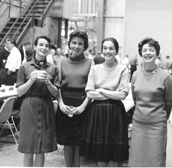
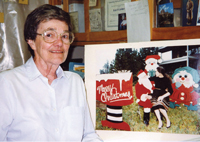 Ruth-Mary
Larimer, shown above in the 1960s (third from the left) and in a more
recent picture, was “the heart and soul of the cyclotron”
according to her colleagues.
Ruth-Mary
Larimer, shown above in the 1960s (third from the left) and in a more
recent picture, was “the heart and soul of the cyclotron”
according to her colleagues.
Scholarship recipient Jennie Sara Guzman graduated from Fresno’s Central High School in 2000, attended Fresno City College, and transferred to UC Berkeley last fall, the first in her family to go to college. She was awarded the Pomerantz physics scholarship and plans to study atomic physics in graduate school. Recommended for the Larimer scholarship by her professor, Dmitry Budker, she was selected by an NSD group on the basis of her outstanding academic performance, involvement in research, hard work, and commitment to a physics career.
Ruth-Mary Larimer’s friends and colleagues founded the Larimer
scholarship after her death, collecting donations of $4,500. Additional
contributions are welcome. (Checks payable to UC Regents should be
sent to Virginia Rapp, 366 LeConte Hall, UC Berkeley, Berkeley, CA
94720-7300; or call Rapp at 643-2317.)
Illustrator by Day, Rock Star by Night
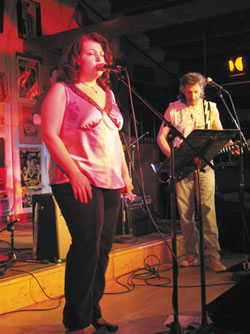 Julia
Turner in concert on Tuesday night.
Julia
Turner in concert on Tuesday night.
Julia Turner still remembers the first time she set foot in the BandWorks warehouse rehearsal hall at Jack London Square in Oakland. She was asked why she was there.
“I’m here because I’m terrified,” she recalls saying to the studio managers. “I need to learn how to do this. I need to explore this side of me.”
The Berkeley Lab side of Turner is technical illustrator, one of the tasks she’s been performing in the Environmental Energy Technologies Division for more than six years. But her alter ego is lead singer for a blues-rock band called Cheaper Than Therapy, which last Tuesday evening blistered the walls of the Ashkenaz Club in Berkeley with its pulsating, emotional covers of songs like “Precious,” “Special,” and “Can’t Find My Way Home.”
Getting to this point hasn’t been easy, Turner recalls. Those first few sessions at BandWorks, a workshop of musicians that assembles aspiring artists into combos and teaches them how to develop a stage act, were intimidating. “I could barely walk up to the microphone,” she recalls. “I had a lot of stage fright to work through. But then I remembered a lot of my acting training.”
When she was 10, Turner became a member of the Walnut Creek Young Repertory Theatre, and she combined that training with operatic voice lessons to perform in numerous musicals at Las Lomas High School. Her mother, a concert pianist, and her father, an artist, helped shape what looked to be a bright future on stage.
However, after a short stint at San Francisco State, she abdicated to southern California, where after a year she discovered “no culture and very bad coffee.” Upon her return, she bounced through a variety of jobs as office manager for small high-tech firms, draftsperson for an interior design company, and production manager for an art publisher. She also majored in interior architecture at the California College of the Arts.
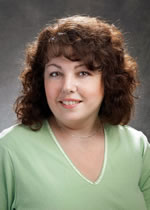 Photo
by Robert Couto, CSO
Photo
by Robert Couto, CSO
It wasn’t until a friend demanded she pursue her dream that she began singing again. Last January after a Google search, she anxiously entered BandWorks. Since then, she’s worked through three eight-week rehearsal sessions (and a summer on her own), hired a voice teacher, and surrounded herself with a group of musicians with complementary interests. There’s Rick, a videographer who plays bass and guitar; “chick” drummer Jessie, a dentist; guitarist Lawr, a Pac Bell systems troubleshooter; and lead guitarist John, a vice president at the Lehman Brothers financial consulting firm.
“Rick gave us our name,” Turner recalls. “At his first session, they asked him why he was there. And he said, ‘Well, it’s cheaper than therapy.’”
Is she serious? Would she trade making posters and designing websites for the life of a rock star, at age 39?
“I’m hoping it turns into something,” she says with a confident smile. “It has become a driving focus in my life.”
Chu Urges Nanoscience To Seek Energy Solution
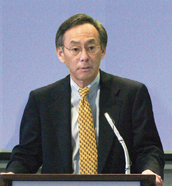
Berkeley Lab Director Steven Chu
Berkeley Lab Director Steve Chu issued a challenge on Tuesday to several hundred scientists and technology leaders at the International Congress of Nanotechnology in San Francisco. Borrowing from his favorite philosopher, Yogi Berra (“Making predictions is very difficult, especially about the future”), Chu urged them to apply Mother Nature’s engineering successes to solving maybe the biggest crisis facing the planet — CO2-neutral energy sources when carbon-based fuels run out.
He told them Americans would most likely place national defense, homeland security, and health very high on their list of priorities, while a solution to sustainable energy would be way down their lists.
“We are working hard to find cures to cancers, heart disease and stroke,” he told the audience at the Airport Marriott Ballroom. “If in 50 to 100 years we do not find these cures, it would be tragic, but life as we know it will continue. However, if we don’t solve the energy problem, life as we know it may not continue. Maybe your nanotechnology can find a solution to this problem.”
Chu likened the approaching crisis to a lava flow on a tropical island, where there is no escape from the island and there is a clear need to find a way to divert the lava flow before it destroys the entire island.
“One can imagine a meeting of the Village Elders,” he said. “One elder might say, ‘Our political system is only set up to address problems on a two- or four-year cycle, and we can not deal with a hundred-year problem.’ The ‘free-market elders’ could say, ‘Don’t worry. When the lava flow gets close, market forces will spur the economy to find a solution.’ Others might say, ‘We don’t really know if the lava will destroy the village in 50 years or 500 years. We need to be sure of our facts before we get too worried.’
“My concern,” Chu added, “is that we may not have enough time to find a solution if we waited. Actually, I cannot imagine this conversation among the Village Elders. Why? Because the lava flow, no matter how slowly it is moving, is visible to everybody on the island, and they realize that eventually, it will get to the village. The energy problem is not visible to the American public.”
Sharing graphs that chart the evidence of global warming and of dwindling fossil fuel energy production, Chu noted that by 2025, world consumption of energy will have tripled since 1970. Domestic energy production in the 48 states peaked in the 1970s, and the world’s production peak is expected some time in the next few decades.
What are the alternatives to energy once we deplete fossil fuel? Fission may be a solution, but Chu said the problems of possible proliferation of nuclear material and the long-term waste storage must be solved first. Fusion is a potential solution, but there are no guarantees it will become economically feasible despite current investments. The other possibility is some form of solar energy that includes wind and photovoltaic devices. One technical problem with the direct generation of electricity is that there’s no economic way of storing electrical energy from solar.
Chu’s advice (Yogi again): “You can see a lot by watching.”
“Perhaps we can learn from watching biological systems where ‘bugs’ have had billions of years to engineer the bugs out of the system,” he told the group. “Photosynthesis, for example, converts solar into chemical energy. If scientists could, in a nanosystem, adapt biology’s method of converting sunlight, CO2 and nutrients into chemical fuel, then the interface between physics, chemistry, biology and nanotechnology may provide a solution.”
He began his keynote talk with a technical primer on how the human inner ear converts sound into electrical signals that are sent to the brain, using a variety of marvelous “engineering” solutions to maximizing the sensitivity and robustness of the ear. He also illustrated how proteins are made by the ribosome, and particularly how beautiful and efficient the process is that selects the correct amino acid that correspond to the messenger RNA instructions.
“I don’t know if this will be a solution (to the energy problem),” he said. “But we’re starting to get people together at the Lab to brainstorm. I am optimistic because these are new ideas, and very powerful technologies are being invented. I would like to see Lawrence Berkeley Lab play a major role in this.”
Isn’t this also a social, political and ethical challenge, he was asked by one listener.
“One of the reasons I took this job is I now have a pulpit for talking about this,” he responded. “[Energy development] is directly in line with the mission of the Department of Energy. When I talk with Congressmen and administrators in Washington, I’ve found that this stuff resonates with them. I want to make them see clearly the creeping lava, and the need to do the basic science that will point a way to a technological solution.”
Berkeley Lab Hosts DOE Laboratory Women’s Forum
The future of women in science and technology got a boost for two days in late October when Berkeley Lab hosted the 2004 DOE Laboratory Women’s Forum.
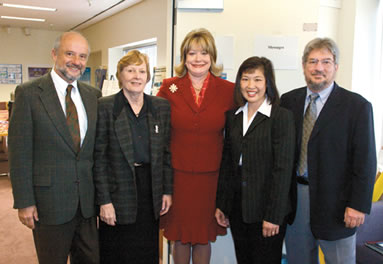 From
left to right are Pier Oddone, Dorothy Bishop of Livermore Lab, Congresswoman
Ellen Tauscher, Laura Chen, and Livermore Lab Director Michael Anastasio.
From
left to right are Pier Oddone, Dorothy Bishop of Livermore Lab, Congresswoman
Ellen Tauscher, Laura Chen, and Livermore Lab Director Michael Anastasio.
The conference, entitled “New Directions — Women of Influence in the National Laboratories,” brought together more than 150 people from Berkeley Lab, Lawrence Livermore and Los Alamos National Laboratories, and both the California and New Mexico sites of Sandia National Laboratories. It marked the third time since 1999 that women from the national labs have convened the forum, and the first time Berkeley Lab has hosted the event.
Among the many speakers and events was an impassioned call by Congresswoman Ellen Tauscher to do as much as possible to increase the ranks of women in all facets of science, including executive positions.
“We need to make sure there are so many women in science and technology that it is unambiguous that they lead,” said Tauscher, who represents the 10th Congressional district, which includes Contra Costa, Alameda and Solano Counties. “We may not have a woman president in our lifetime, but we will have a woman running a national lab in our lifetime.”
The forum began Oct. 26 with tours of the UC Berkeley campus and Berkeley Lab, followed by a welcome dinner and opening remarks by Sally Benson, deputy director for Operations. Director Steven Chu commenced the second day of the meeting by addressing a packed Building 66 auditorium.
“I really lend my support to this initiative. Things have gotten better, but quite frankly there is a long way to go,” said Director Chu. “Certainly, what I call the ‘underrepresented majority’ can contribute equally. We really have a need for as broad a pool as possible in science and technology.”
DOE Berkeley Site Office Man-ager Dick Nolan followed. “On behalf of DOE Office of Science, I applaud your goal of paving the way for recruiting women to science and technology positions. The importance of women in the technical workplace is absolutely critical to DOE, the U.S. and the world.”
A panel discussion explored the impacts of science and technology on women’s issues. This was followed by Tauscher’s humorous and heartfelt speech that touched on her role as a woman in typically male arenas, and the importance of getting women interested in science at younger ages.
“I have gone from one male-dominated institution to another, from my parents’ house, to the first women’s class of Seton Hall Univer-sity, to Wall Street, to Congress,” said Tauscher, who at age 25 became one of the first women to hold a seat on the New York Stock Exchange. She added that today’s women scientists must serve as role models for the next generation of women scientists and engineers. “There are millions of young girls out there, and that is our hope and future. We need to help them.”
She also emphasized that it is up to women to pave the way for women.
“Unless we take the time and energy to get more women in science and technology fields, it will remain undone,” she said. “For them, meaning men, it still remains in ‘the nice to have category.’ But for us, it falls in the ‘have to have category.’”
Laura Chen, Berkeley Lab’s host and organizer of the Forum, said the event exceeded her expectations. “We surpassed our attendance goal by 50 percent, and we were honored by the presence of many distinguished leaders in our community,” she said. “The next step is to pull together a Berkeley Lab contingent that focuses on ways to advance the recruitment, promotion and retention of women scientists, professionals and managers.”
SHARES Campaign Enters Final Two Weeks
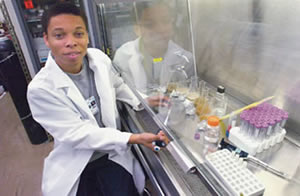 The
Berkeley Biotechnology Education program, one of the local organizations
helped by the SHARES campaign, is opening new doors for students like
Arthur Martin.
The
Berkeley Biotechnology Education program, one of the local organizations
helped by the SHARES campaign, is opening new doors for students like
Arthur Martin.
Arthur Martin hopes to attend Texas A&M University next year and eventually get a job in the biotechnology field. He owes his goal in part to Berkeley Biotech-nology Education, Inc. (BBEI), a nonprofit organization that builds interest in science and technology careers among student populations typically underrepresented in the sciences.
“The program has opened a lot of doors for me,” says Martin, who graduated from Berkeley High School last year and has been working for several months with Tamas Torok in Berkeley Lab’s Life Sciences Division. “I would recommend the program to any student hoping to learn more about biotechnology careers.”
Since 1992, more than 500 local high school students have graduated from the program, which includes a high school biotechnology class, summer internships, and a paid yearlong co-op job with institutions such as Berkeley Lab, currently hosting three students. According to BBEI Executive Director Kelly Wallace, 60 percent of the students who graduated from the program obtain entry-level technical biotechnology jobs, and almost 40 percent continue their education in college. And although the students don’t pay to participate, the program is far from free.
“We absolutely depend on individual donations to provide our service,” says Wallace, who oversees a $500,000 annual budget.

To help organizations such as BBEI help the next generation of scientists and lab technicians, Berkeley Lab employees have until Nov. 24 to participate in the SHARES campaign. SHARES supports the Lab’s commitment to assist organizations that depend largely on donations. The campaign started Nov. 1, and as of Nov. 9, 37 employees have donated a total of $10,540.
The Lab will host a charity fair next Tuesday, Nov. 16, from 11:30 a.m. to 1:30 p.m. at the cafeteria to give employees a chance to learn more about BBEI and 12 other local charities.
The Bizarre Insides of Neutron Stars
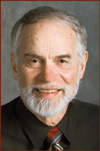
Norman Glendenning
How do quarks freeze inside neutron stars? When Frank Wilczek, who shared this year’s Nobel Prize in physics, and his colleague Krishna Rajagopal advanced a “smooth” alternative to the complex geometry proposed by Berkeley Lab’s Norman Glendenning, they conceded that only observation can settle the question. In September astronomers announced the best measurements yet of a neutron star’s mass and radius, suggesting that the answer may be coming closer.
In the 1980s Norman Glendenning of the Nuclear Sciences Division worked at the Bevatron/Bevalac, studying the way nuclear matter changes when subjected to extremes of pressure, density or temperature. Bevalac experiments produced fleeting states of matter with up to three times the density of the nucleus.
“But when I considered what one could learn from the interior of a neutron star, with ten times nuclear density, I rather lost interest in the accelerators of that era,” says Glendenning. He was soon proposing ideas about neutron stars that theorists and observers are still grappling with today.
Neutron stars are only 10 to 20 kilometers across, with surface gravity 100 billion times greater than Earth’s. Toward the center of the star matter is crushed ever closer together, until at some point quarks become “deconfined,” popping out of their little hadron bags — neutrons and protons are the most familiar hadrons — to form a soup of free quarks and gluons, which normally keep quarks stuck together.
Theorists used to think of this phase change — from the confined-quark to the deconfined-quark stage — as analogous to a phase change in water, for example from liquid water to ice. But phase changes in water, says Glendenning, “are first-order transitions with only one independent component” — namely water itself. “The situation is much more interesting for substances with two or more components.”
To illustrate the point, Glendenning uses a vivid metaphor: “Suppose water had two independent components and one of them was electric charge, with opposite charge on the ice than on the water. Then a lake would not freeze over, starting with a sheet of ice on top, but ice spheres would form throughout the volume of the lake.”
Going through a phase
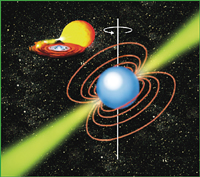 If
a spinning neutron star's magnetic field is not aligned with its rotation
axis, the drag of electromagnetic radiation slows it down (foreground).
But a neutron star that accretes matter from a companion star becomes
more massive and spins ever faster (background).
If
a spinning neutron star's magnetic field is not aligned with its rotation
axis, the drag of electromagnetic radiation slows it down (foreground).
But a neutron star that accretes matter from a companion star becomes
more massive and spins ever faster (background).
In neutron-star phase changes, electric charge is one of two components that vary. Despite its name, a neutron star is not made solely of neutrons, but includes protons, electrons, and a host of weirder species; while global neutrality must be conserved, local regions can have excesses of positive or negative charge.
A second component is baryon number, which must also be conserved. Hadrons have positive baryon numbers, while their antiparticles have negative baryon numbers.
In this two-component system, local trade-offs conserve baryon number and global electrical neutrality. Under extreme pressure, neutrons can become protons by transferring electric charge to quarks — changing up quarks into strange quarks, for example. The result is a region of positively charged nuclear matter with negatively charged quark matter embedded in it as droplets, like those imaginary spheres of ice in liquid water.
As pressure increases the proportion of quark matter increases, and the droplets elongate to rods; with still more pressure, the rods join into slabs. Finally quark matter dominates: the hadrons inside it form slabs, rods, and finally droplets, just before the system turns to pure quark matter.
Glendenning jokingly refers to this as a pasta model: “Drops
like orzo, rods like spaghetti, slabs like lasagna.” A bizarre
picture, but can it ever be tested by observation?
Putting a spin on the ball
Glendenning was inspired by the phenomenon of “backbending” in the spin of certain atomic nuclei, which temporarily slow down after being created, pausing to realign pairs of neutrons and protons before spinning faster again.
Tiny atomic nuclei aren’t much like neutron stars, but Glendenning found the analogy striking: changing the state of one part of a rotating system has a noticeable temporary effect on the spin rate of the whole.

If phase changes in water occurred in a system with two oppositely
charged components, instead of freezing from the top down, spheres
of ice would form in the liquid.
Two conditions that affect the spin of a neutron star are drag and mass accretion. A pulsar is a neutron star that emits a broad band of electromagnetic radiation, which drags on the star and gradually slows it down. A neutron star that slowly sucks matter from a companion star spins increasingly faster as mass increases.
As a pulsar spins slower, interior pressure grows as centrifugal forces decline; incredibly dense, pure quark matter forms or increases at the center. More quark matter forming at the star’s center forces the whole structure to spin up again — temporarily.
The same glitch can happen in reverse. A star that’s accreting matter and spinning faster has less internal pressure, which will cause its quark-matter core to change to a less dense mixed phase, temporarily causing the star to slow down.
This “backbending” of spin should be detectable as an increase in the number of neutron stars spinning at certain rates, among a population of neutron stars whose spin rates otherwise vary smoothly. Until enough neutron stars are catalogued, the question remains open.
Astronomers are using new kinds of measurements to determine the
mass and radius of neutron stars by observation, and theorists argue
over what exotica may be found within them. Norman Glendenning’s
studies are an inevitable part of the continuing intellectual ferment.
Berkeley Lab View
Published every two weeks by the Communications Department for the employees and retirees of Berkeley Lab.
Reid Edwards, Public Affairs Department head
Ron Kolb, Communications Department head
EDITOR
Monica Friedlander, 495-2248,
msfriedlander@lbl.gov
Associate EDITOR
Lyn Hunter, 486-4698 lhunter@lbl.gov
STAFF WRITERS
Dan Krotz, 486-4019
Paul Preuss, 486-6249
Lynn Yarris, 486-5375
CONTRIBUTING WRITERS
Jon Bashor, 486-5849
Allan Chen, 486-4210 David Gilbert, 925-296-5643
FLEA MARKET
486-5771, fleamarket@lbl.gov
Design & Illustration
Caitlin Youngquist, 486-4020
TEID Creative Services
Communications Department
MS 65, One Cyclotron Road, Berkeley CA 94720
(510) 486-5771
Fax: (510) 486-6641
Berkeley Lab is managed by the University of California for the U.S. Department of Energy.
Online Version
The full text and photographs of each edition of The View, as well as the Currents archive going back to 1994, are published online on the Berkeley Lab website under “Publications” in the A-Z Index. The site allows users to do searches of past articles.
LDRD FY 2005 allocations
Berkeley Lab Director Steven Chu announced the awards for the Fiscal Year 2005 Laboratory Directed Research and Development (LDRD) program (see the March 5, 2004 issue of the View for the Call for Proposals). A total of about $13.4 million in operating and capital equipment will go to 78 projects chosen from a field of 165 proposals. Of these, 40 are new and 38 are continuation projects. The evaluations used input from divisional reviews as well as laboratory-wide review committees.
In making the awards, Director Chu said, “This year’s LDRD proposals were exceptional in their quality, creativity, and scientific promise, and therefore we had a highly competitive field from which to chose. I greatly appreciate the efforts of all proposal scientists in offering many promising directions for Berkeley Lab.”
|
Ahmed |
Gas Phase Studies of the Building Blocks of Life |
80 |
| Alivisatos et al. |
Studies of the Health Effects of Nanostructured Materials |
300 |
| Alvarez-Cohen |
Application of Real-time PCR With Reverse Transcription for Quantification of Specific Microbial Activity in Complex Communities |
80 |
| Auer |
Molecular Microscopy and Tomography |
200 |
| Battaglia |
Silicon Detector Technologies for a Linear Collider |
180 |
| Biggin et al |
High Throughput Strategy for Protein Complex Identification |
200 |
| Bishop |
Autonomous Sensors for Ocean Dissolved Organic Matter |
250 |
| Borglin et al |
Development of Biosensors for Endocrine Disrupting Compounds in Agricultural Watersheds |
90 |
| Cavalleri et al |
Ultrafast Measurements of Charge-ordering/ disordering in Manganites: Development of a Femtosecond Electron Diffraction Probe |
100 |
| Celniker et al |
Modeling Human Disease in Drosophila melanogaster |
150 |
| Chakraborty et al. |
Organization of Cellular Components on Signaling and Function: Theory and Computation as Essential Complements to Genetic and Biochemical Experiments |
200 |
| Chang |
Oxygen Catalysis through Proton and Electron Control: Biomimetic Chemistry for Renewable Energy |
77 |
| Chevassut |
Cryptographic Foundations for New Generation Distributed Systems |
130 |
| Conboy |
Unmasking the Human Genome Alternative Splicing Program |
150 |
| Dahmen |
Techniques of Sample Controls for a Transmission Electron Aberration-Corrected Microscope |
250 |
| Denes et al. |
Novel Imaging Detectors for Materials and Biology Research |
400 |
| DePaolo et al |
Micro-characterization and Chemical Micro-dynamics of Atmospheric Mineral Dust |
100 |
| Dubon et al |
Au-mediated Assemby of Ge Island Arrays on Si |
100 |
| Earnest |
High-throughput Production of Proteins and Protein Complexes |
120 |
| Fischer |
Constraining Ammonia Emission Inventories for Control of Air Quality |
230 |
| Fletcher |
Synthetic Cytoskeleton: Protrusive Structures for Reconstituted Cell Motility |
70 |
| Frechet et al. |
Organic Electronics |
200 |
| Geissler |
Microscopic Theory of Protein Surface: Structure, Response, and Design |
113 |
| Gilbert et al |
Behavior and Impact of Nanoparticles in the Environment |
150 |
| Gray et al |
Functional Interpretation of Cancer Genomes |
600 |
| Hamann |
Investigative Visualization Methods for Exploration and Comparison of Multi-Billion Base Pair Sequence Data |
80 |
| Hang |
Computational Analysis of Structural Impacts of Exocyclic DNA Adducts on Specificity and Efficiency of Human Repair Enzymes |
50 |
| Heeger et al |
Designing a Novel Reactor Neutrino Oscillation Experiment for Measuring the Unknown Mixing Angle Q 1,3 |
300 |
| Hoschek |
Peer-to-Peer Resource Discovery Framework |
90 |
| Howells |
Coherent X-ray Diffraction Imaging (CXDI) |
250 |
| Isacoff et al. |
Engineering of Nature’s Ion Channels and Transporters to Use Light as Both a Signal and an Energy Source |
200 |
| Jagust |
Neuroimaging with Advanced Molecular Probes |
370 |
| Johnson et al. |
Highly Efficeint PLED Through Polymer Morphology Control |
200 |
| Kirz |
Lensless Imaging of Yeast Cells |
45 |
| Kostecki, Balsara |
Novel High-temperature Membranes and Electrocatalyst Structures for Fuel Cells |
150 |
| Leone |
Time-resolved X-ray Absorption Spectroscopy of Metalloporphyrins |
100 |
| Lesko |
Research and Development for Double Beta Decay Experiments |
300 |
| Lester et al |
Development and Application of Quantum Monte Carlo (QMC) Methods to Biological Systems |
100 |
| Liddle, Balsara |
Nanoscale Lighography to Guide Self-Assembly for the Creation of Functional, Hierarchical Nanostructures |
100 |
| Lidia et al. |
Critical Accelerator Technologies for Advanced Light Sources |
860 |
| Liphardt |
Rapid Characterization of Nucleic Acid Using Nanopores |
150 |
| Logan et al |
Enabling High Energy Density Physics at LBNL |
350 |
| Majumdar et al |
Thermoelectricity in Nanostructured Complex Oxides |
100 |
| Mao, Russo |
Nanostructured Cathodes for Efficient Organic LEDs |
154 |
| Martin |
Left-handed Nanoscale Meta-Materials: Towards the Optical Domain |
150 |
| Martin, Bissell |
Imaging Three-Dimensional Signaling Networks in Normal and Malignant Tissue |
100 |
| Marx |
Development of Key Physics and Technical Approaches for the Production of Intense Rare Isotope Beams |
250 |
| McMahan |
Establishing New Capabilities in Nuclear Astrophysics and Radiation Biology Using Neutrons at the 88" Cyclotron |
150 |
| Menon |
Evaluating Aerosol Effects on Regional and Global Energy and Water Budgets |
100 |
| Meyer et al |
Optimizing Genomic Data Storage for Wide Accessibility |
100 |
| Meza |
Parallel Methods for Robust Optimization and Uncertainty Quantification |
135 |
| Miller et al. |
The California Water and Energy Systems: An Approach for Addressing Future Crises |
200 |
| Moridis, Finsterle |
Next Generation Codes for Modeling Subsurface Processes |
120 |
| Murayama |
New Directions for Theoretical Physics at the TeV-Scale |
250 |
| Myers |
Making the Most of Sequencing: Improved Assembly, Improved Protocols, and True Comparative Annotation Tools |
150 |
| Neumark |
Spectroscopy and Dynamics of Pure and Doped Helium Nanodroplets |
100 |
| Newman |
Analysis of High-temperature Polymer-electrolyte Fuel Cell Phenomena |
100 |
| Oliker et al |
Enhancing Commodity Processors with Vector Components for Increased Scientific Productivity |
200 |
| Phair |
Improved Spectroscopy of Weakly Bound States in Nuclei |
150 |
| Pinar et al. |
Advanced Computational Tools for Electric Power Systems |
250 |
|
|
|
|
| Rescigno, McCurdy |
Advanced Computational Methods for Photon-Molecule Collision Processes |
300 |
| Romano, Parvin |
Computational Texture Models for Patterns of Protein Expression |
80 |
| Rotenberg |
NanoARPES: A New Detector for Nanometer-scale Electronic Structure Measurements |
160 |
| Rubin |
Transgenic Mouse Production and Identification of New Genes in Transgenic Mice |
65 |
| Ryne |
Optimal Solvers for Infinite-Dimensional Hamiltonian Systems |
100 |
| Sathaye |
World Energy Scenarios: The Crucial Role of Energy Demand |
120 |
| Scholl |
Ultra-fast Magnetization Dynamics |
150 |
| Souza, Louie |
Computational and Theoretical Studies of Bulk and Nano Solid Systems |
60 |
| Sposito |
Advancing the Next Generation of Rock-Fluid Imaging and Stimulation Technologies |
70 |
| Steefel |
Biogeochemical Reaction Rates and Pathways in Porous Media |
100 |
| Suzuki et al |
Complex Oxide Nanostructures: Understanding Surface, Interface, and Finite Size Effects Through Nanofabrication |
80 |
| Tilley |
New Approach for the Catalysis Conversion of Methane and Other Inert Hydrocarbons |
80 |
| Tjian, McDermott |
Development of Techniques for the Study of Large Macromolecular Complexes Using X-ray Crystallography |
70 |
| Vay, Furman |
Electron Production and Collective Field Generation in Intense Particle Beams |
130 |
| Vishwanath, Lee |
Experimental Signatures of Deconfined Phases and Phase Transitions |
70 |
| Wilcox, Schoenlein |
High Average Power Laser Amplifier |
480 |
| Yelick, Hargrove |
Evaluation of Computer Architecture Alternatives |
165 |
| Zolotorev |
Low Energy Spread Electron Source |
130 |
|
|
Total Allocation |
13,384 |
Flea Market
- MOTORCYCLES
‘99 HONDA Superhawk, 996cc, 19K mi, yellow, maintained, runs perfect, looks flawless, all stock, includes tank bag, disc lock, rain cover, $4,200/bo, Michael, X6944, (415) 516-4915
HOUSING
ALBANY 2/2 condo on Park Hill, fully furn, spacious 1,234 sq ft, sunny, quiet & eleg, laundry rm, views, pool, DSL, exer & rec rooms, 2-car garage, Geoff, 848-1830, gfchew@mindspring.com
BERKELEY furn rooms, $300/wk or $800/mo, kitchen, laundry, TV, DSL avail, walk to shuttle, shops, Jin 845-5959, jin.young@juno.com
BERKELEY, 1 bl to UCB, lge, nicely furn 1 bdrm apt, $1,575/mo incl computer, DSL, all util, Jin 845-5959, jin.young@juno.com
NORTH BERKELEY B&B, breakfast daily, lovely furn rms, $600/mo, Helen, 527-3252
NORTH BERKELEY by wk/mo, fully furn, 1/1 flat, quiet, spacious, dish TV, laundry rm, priv garden, gated carport, walk to shuttle/UCB/pub trans, Geoff, 848-1830, gfchew@mindspring.com
NORTH BERKELEY, priv lge rm, furn, priv bth, walk dist to UC, grocery, BART, bus, avail now, $700/mo, 524-3739 or cell 928-5092
NORTH OAKLAND, studio, sunny, quiet, priv garden setting, hardwd flrs, kitchen w/ gas stove , bthrm w/tub, dressing room, laundry fac, $800/mo + last mo+ cleaning dep, mo-to-mo, 1 pers only, no pets/smok, Mrs Wurth, 527-5505 aft 1:30 pm, nonet@xoma.com
OAKLAND, 4 bdrm/1 bth, 1,500 sq ft, 1640 & 1642 12th Street, all new appl, tile flrs & countertops, w/d hookup, avail now, $1,750/mo downstairs, $1,850/mo upstairs, dep neg, Rina, 232-1104
OAKLAND/LAKE MERRITT sublet, 2 bdrm/1 bth, avail Feb-July, fully furn, 2nd bdrm used for storage, incl parking, laundry room, pool, water & garbage, close to BART, shops on Lakeshore & Grand, $1,100/mo, Michelle, 325-8604 cell, mshld@yahoo.com
TARA HILLS, 2 bdrms for rent in 4 bdrm/2 bth house, share w/ a female, $650/mo, avail 1/1/05, Liz, X2724, cell, 685-0005, Lbear2500@aol.com
VALLEJO, 1-yr-old townhouse, 4 bdrm/1.5 bth, 1,700 sq ft, yr-old appliances, w/d hookup, avail 11/15, $1,795/mo, dep $1,795, Cori, 205-6533
WEST OAKLAND, 3645 West St, fourplex, 3 bdrm/1 bth, 1,200 sq ft, new title flrs & countertops, new bthtub/shower, w/d hookup, nr MacArthur BART/trans, avail now, $1,495/mo, dep neg, Rina, 232-1104
MISC ITEMS FOR SALE
BUNKBED, red tube metal, twin size, incl mattresses, good cond, $75, Doug, X4567, 568-6386
CHEST BED queen size, honey-pine color, 10 drawers & 1 cupboard, $350, you load, we truck, Art, 237-4654
COUPON, Southwest Airlines Rapid Rewards, valid through 12/11/04 anywhere Southwest flies, $200, Steve, X7855 or (925) 682-6008.
ELECTRIC LIFT CHAIR/RECLINER, Pride model TMR-58, green, w/ heavy duty lift actuator, exc cond, $280, Ron, X4410, 276-8079
ELECTRIC SCOOTER, 1 yr old blk Zappy Classic w/ seat, $150, Chris, X7028, 848-2389
GUITAR, Martin custom D-16RGT, signed C.F. Martin IV, no 161 of 250 produced, mint $875; Minolta X-570 35mm SLR camera, 50 mm lens + Vivitar flash & zoom lens, exc, $100; Cinelli road bike, 52 cm frame, super record throughout, $350, Walter, X6705
SAIL CANOE KIT, sail, lee boards, & rudder, $200; 2 5,000 lb capacity car ramps, $15, Mike, (925) 254-0609
SINGLE BED AND COUCH, both nearly new from Ikea, bed frame has 3 lge drawers underneath, $50; couch is comfy, incl
washable custom-fit slipcover, $50, Lyn X4698
SKIS, 5’3” L Dynastar Outland T-160, 5’ L Salomon XSCREM 700, price neg, Nanyang, 334-9241 cell
VACATION
TAHOE KEYS, 3 bdrm, 2.5 bth house, fenced yard, quiet sunny location, skiing nearby, views, $195/night, 2 night min, Bob, (925) 376-2211
LAS VEGAS, time share, Polo Towers, 5 star in Las Vegas, 2 bdrms, 1 wk every other year or 1 bdrm, 1 wk every year, floating time, highest exch rating w/resorts around the world, www.resortime.com, $17,000/neg, Mustafa, 451-1350, X5081
Flea Market Policy
Submissions must include name, affiliation, extension, and home phone. Ads must be submitted in writing (e-mail: fleamarket@lbl.gov, fax: X6641,) or mailed/ delivered to Bldg. 65. Email address are included only in housing ads.
Ads run one issue only unless resubmitted, and are repeated only as space permits. The submission deadline for the December 3 issue is Wednesday, November 24.
NEXT VIEW OUT ON DEC. 3
Please note that due to the holiday schedule, the View will skip a week. Instead of being published on Nov. 26, the next issue will come out on Dec. 3. The last issue for the year will be published on schedule two weeks later, Dec. 17. Please make note of these changes when submitting items for publication. Happy Thanksgiving!
Open Enrollment Features Benefits and Wellness Fair
Compared to other years, it seems like most of us are hearing little about Open Enrollment this November. According to those who ought to know, this is a classic case of no news is good news.
“The process is running very smoothly,” says Richard Takahashi, head of the Lab’s Benefits Depart-ment. “We’ve had no problems or complaints.”
Most likely, that’s because there are no major changes to Open Enrollment this year and most people feel comfortable using the user-friendly online system. Best of all, there are no rate hikes for employees, with the gross premium increases of 10 to 15 percent being subsidized by the Lab and the University.
But the good news is no reason to ignore an opportunity that comes only once a year (and in some instances, such as legal plan enrollment, more seldom than that). As always, November is the window of opportunity when employees can make changes to many of their UC health and welfare plans — decisions that can have a major impact on their lives and those of their families during the coming year.
To help employees learn about their options, the Benefits Depart-ment is hosting a vendor fair and a few informational sessions, as was the case in previous years. What’s new this time is that a three-hour “Wellness Fair” will be held in conjunction with the regular vendor showcase on Monday, Nov. 15.
“We are dedicating a lot of the effort to the Wellness Fair to make people feel better about themselves,” Takahashi says. “We want people to take charge of their own health and maintain a healthy lifestyle. The fair will present cost effective ways for employees to utilize resources available to them that they may not be aware of.” Featured will be everything from body-fat and blood pressure testing, to yoga class representatives, and health and fitness club reps and raffles.
Employees who did not previously sign up for the legal plan may want to take special note that the plan, which changed vendors last year, is open for enrollment this month. Next year, Takahashi says, this may not be the case.
Also keep in mind that you need to re-enroll in the various tax savings programs to continue participation, even if you signed up previously. These include the Health Care Reimbursement Account (HCRA) and the Dependent Care Reimbursement Account (DCRA).
To enroll online, see UC’s AtYourService website and click on “Open Enrollment” (top right). To make changes, employees will need to replace their old personal identification number (PIN) with a new 6-to-12 digit password, for improved security. (Log on with your old PIN and then make the change and proceed with enrollment.) Detailed Open Enrollment information can be found on the site.
Questions regarding Open Enrollment may be directed to the Lab’s Benefits Department at X6403 or benefits@lbl.gov.
Open Enrollment Information
Remaining sessions
Vendor and Wellness Fair
Nov. 15, 11:30 a.m. – 2:30 p.m. Perseverance HallTraining Sessions
Offsite: Nov. 16, 2 p.m.
OSF, Oakland
Onsite: Nov. 18, 9 a.m.
Building 50 auditoriumVendor Fair for Retirees
Nov. 16, 8 – 11 a.m.
Oakland Convention Center/ Marriott Hotel